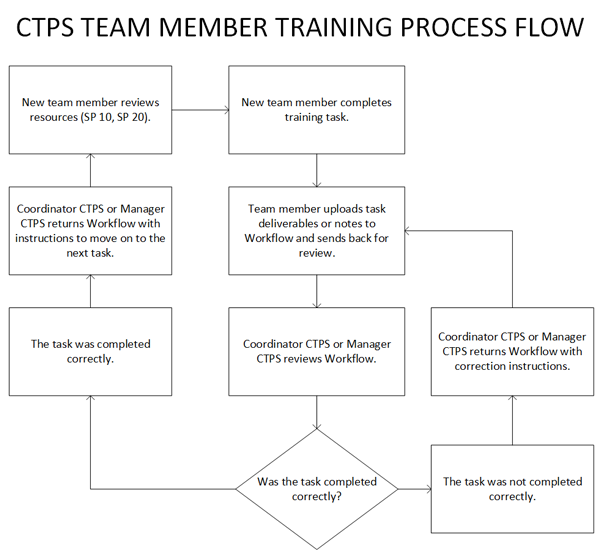Creating a training path to fit the needs of a dynamic team
Quick Info
- Project: CTPS Training Guidebook and Process
- Timeline: March 2019 to January 2020
- Team: Lesayah Hinojosa, Kevin Wiklund, Erica Campbell, Shay Pendleton
The existing training system for incoming Corporate Technical Publications and Standards (CTPS) team members was fragmented and quickly became outdated due to our team’s ever-changing processes and technological tools. Lesayah Hinojosa, a specialist at the time, expressed a desire to reconsider the entire system, and we were off to the races.
Objective
When we first considered this project, we wanted to create a training path and program that was:
- Responsive to change: The existing training detailed procedures with such specificity that it became restrictive. New employees didn't have room to find better ways of performing a task. In addition, this specificity was a downfall when any process would change. We wanted to create a training program that would remain applicable to a process even when that process evolved.
- Easy to revise: The existing training contained redundant information that was detailed more thoroughly (and more recently) in other Company documents. We wanted to only include the information that was necessary.
- Appropriate for the needs of the team: The existing training was very insular and isolated new trainees from the rest of the team. We wanted the new process to approach training as a team effort that allowed seasoned team members to fill in any gaps and check in with trainees at every step of the process by creating a document that would travel through our Workflow process entirely naturally.
We allowed ourselves to be a little playful with the content of the documents (e.g., trainees created a bulletin that detailed a change in the office candy policy).
My Role

I oversaw the creation of the guidebook, brainstormed topics, and provided feedback during the initial creation. I also helped to write guidebook sections, added suggestions along the way, and created external documentation (on the management side) that would interface with the new process.
Challenges
Because our team’s processes are somewhat complex, we needed a training guidebook that would both comprehensively cover several diverse steps of document revision (using multiple programs, including Arbortext Editor and Content Manager, Outlook, Visio, and Adobe Acrobat). Our team’s processes also frequently change as we find new tools and respond to new regulation, so we needed something that would be able to be easily customized on the fly (if needed). Our solution was to create a controlled guidebook that contained instructions and references to other internal manuals that were frequently revised, so the trainee would always be pointed to the most current information.
Approach

Our approach to revising the training process took the following steps:
- First, we reviewed and researched the current training path and past training documents. Lesayah dug through our file archives and read through some guides and training that had been apparently created and abandoned. We discussed what worked and what didn’t, what was missing, and what was no longer relevant.
- Then, we brainstormed with the entire team on elements they believed were missing and what should be included in our weekly team meeting.
- Lesayah created a draft outline of the revised training guidebook and, after agreeing on the layout, we divided up the chunks between the two of us for writing. She mainly took on writing sections for processes that were more “daily tasks,” and I wrote out the processes for tasks that were more technical and specialized.
- We drafted, drafted, drafted. We met weekly to discuss our progress on writing and sent sections out to the rest of the team to test them out as though they were a new trainee.
- Last, we finalized the new process and shared it among other tech writing groups in the company, with the recognition that the documents would be revised to respond to new trainees’ experience.
The previous training flow was a very insular and linear process for the new trainee, with little room for organic feedback and improvement. The new process we created mimicked the actual work flow of a normal project on the team, with iterative loops of document revision and review.
Final Deliverables
- Training Guidebook: A step-by-step procedural guidebook that walked new team members through the training process.
- Mock SP: A "fake" manual created in SkyWest's standard format that new team members would recreate through their training.
- Training Path Form: A detailed training path that included both the new training guidebook procedures and face-to-face presentations, shadowing, administrative tasks, and other elements of an office training.
Outcome
The first trainee to use the new training process was hired at the end of February 2020, about three weeks before COVID-19 pushed our team to start working remotely. She had just enough time to complete the training in the office before she was on her own. The training program helped prepare her to both work independently and collaborate with team leadership, when required. The skills she had built during the training served her very well while working remotely, and, as a manager, I was very relieved to know exactly what she had been trained on and what she still needed to learn.